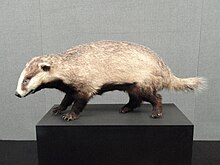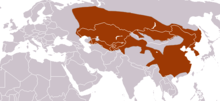Meles leucurus
| Asian badger | |
|---|---|
 |
|
| asian badger | |
| Scientific classification | |
| Kingdom: | Animalia |
| Phylum: | Chordata |
| Class: | Mammalia |
| Order: | Carnivora |
| Suborder: | Caniformia |
| Family: | Mustelidae |
| Subfamily: | Mustelinae |
| Genus: | Meles |
| Species: | M. leucurus |
| Binomial name | |
|
Meles leucurus Hodgson, 1847 |
|
 |
|
| Asian badger range | |
The Asian badger (Meles leucurus), also known as the sand badger is a species of badger native to Mongolia, China, Kazakhstan, the Korean Peninsula and Russia.
Asian badgers are mostly lighter in colour than European badgers, though some forms may closely approach the former species in colour, if not darker, with smudges of ocherous and brownish highlights. The flanks are lighter than the middle of the back, and the facial stripes are usually brown rather than black. Unlike the facial stripes of European badgers, those of Asian badgers narrow behind their eyes and extend above the ears. The white parts of the head are usually dirtier in colour than those of European badgers. The light stripe passing along the top of the head between the two stripes is relatively short and narrow. They are generally smaller than their European cousins, and have relatively longer upper molars. They indeed appear to be the smallest of the three Meles badgers despite regional size variations, with the largest-bodied populations of the species found in Siberia where some populations are about the same size as the European badger. Body mass will typically range from 3.5 to 9 kg (7.7 to 19.8 lb) and length from 50 to 70 cm (20 to 28 in). The average weight of three adult males from Sobaeksan National Park, South Korea was 6 kg (13 lb).
Five subspecies are recognised.
schrenkii (Nehring, 1891)
Asian badgers have a large range including the southern portion of Russia east of the Urals, Kazakhstan, Mongolia, China, and Korea. The species can be found within areas of high elevation (perhaps up to 4,000 metres (13,000 ft)) in the Ural Mountains, the Tian Shan mountains, and the Tibetan Plateau. The ranges of Asian and European badgers are separated in places by the Volga River. Asian badgers prefer open deciduous woodland and adjacent pastureland, but also inhabit coniferous and mixed woodlands, scrub and steppe. They are sometimes found in suburban areas.
...
Wikipedia

